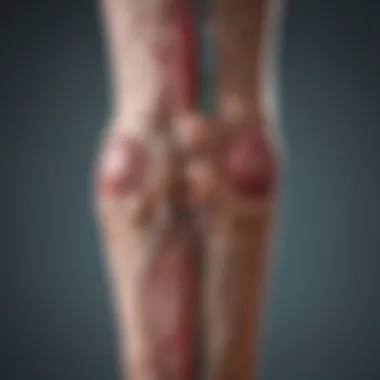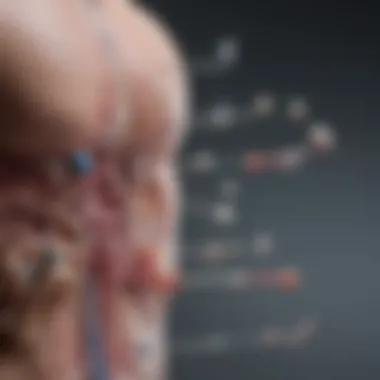Intravenous Neuropathic Pain Medications Overview


Intro
Intravenous medications for managing neuropathic pain represent a critical component of modern pain management strategies. Neuropathic pain itself is a complex condition resulting from damage to the nervous system. This overview aims to provide insights into the pharmacological options available through intravenous administration. Understanding the mechanisms, benefits, and challenges of these medications is essential for both healthcare professionals and patients.
Key Concepts and Terminology
Definition of Key Terms
- Neuropathic Pain: A type of pain caused by damage or disease affecting the somatosensory nervous system. It often presents as burning, tingling, or sharp sensations.
- Intravenous (IV) Therapy: The administration of medication directly into the bloodstream through a vein. This approach allows for rapid delivery and higher bioavailability of drugs.
- Pathophysiology: The study of how disease processes affect the function of the nervous system, contributing to the sensation of pain.
Concepts Explored in the Article
In this article, key concepts around intravenous neuropathic pain medications will be discussed, including:
- The pathophysiology of neuropathic pain.
- Various intravenous medications and their mechanisms of action.
- Clinical considerations surrounding the use of IV therapies.
- Potential side effects and challenges associated with intravenous treatments.
- Trends and future directions in neuropathic pain management.
Findings and Discussion
Main Findings
The review of intravenous medications reveals several important findings:
- Medications such as Gabapentin, Pregabalin, and Ketamine have shown efficacy in managing neuropathic pain when delivered intravenously.
- The rapid onset of pain relief associated with IV administration can greatly enhance patient outcomes.
- Patient-specific factors, such as underlying health conditions and tolerance to medications, can impact the effectiveness and safety of IV therapies.
"Understanding the pharmacological profiles of IV neuropathic pain medications can significantly improve patient satisfaction and treatment adherence."
Potential Areas for Future Research
Future research in intravenous neuropathic pain medications may focus on:
- Improving patient selection criteria for IV therapy to maximize benefits while minimizing risks.
- Exploring new pharmacological agents and their potential applications.
- Long-term effects and outcomes of intravenous treatments for chronic neuropathic pain.
In summary, intravenous therapies offer a promising avenue for managing neuropathic pain, with ongoing research needed to refine treatment protocols and optimize patient care.
Prologue to Neuropathic Pain
Neuropathic pain represents a complex and often debilitating condition that requires a nuanced understanding for effective management. Recognizing the intricacies of neuropathic pain is crucial for healthcare professionals who aim to provide effective treatment strategies. This section highlights the definition, epidemiology, and underlying mechanisms of neuropathic pain, laying the foundation for subsequent discussions about intravenous medications.
Definition and Characteristics
Neuropathic pain is defined as pain caused by a disorder of the somatosensory system. It is characterized by a range of symptoms, including burning sensations, tingling, and increased sensitivity to stimuli. This kind of pain can arise from various factors such as nerve injury, diabetes, or infections. The unique qualities of neuropathic pain differentiate it from nociceptive pain, complicating its diagnosis and treatment. Patients may describe their pain in subjective terms that do not correlate with traditional pain scales, making evaluation challenging. Recognizing these distinctive characteristics is essential for implementing effective pain management protocols.
Epidemiology and Impact
The prevalence of neuropathic pain is significant, affecting millions globally. Conditions such as diabetes mellitus and postherpetic neuralgia are among common causes. As the population ages, the incidence of neuropathic pain is likely to increase, presenting a growing challenge for healthcare systems. The impact of this pain extends beyond physical discomfort; it can lead to emotional distress, reduced quality of life, and increased healthcare costs. Understanding the epidemiology of neuropathic pain is vital for developing strategies aimed at prevention and management.
Pathophysiology of Neuropathic Pain
The underlying mechanisms of neuropathic pain are multifaceted. It often involves abnormal processing of pain signals in the peripheral and central nervous systems. Changes in neuronal excitability and alterations in neurotransmitter levels can perpetuate the sensation of pain even after the initial injury has healed. This maladaptive response complicates treatment paradigms, necessitating a comprehensive approach that may include pharmacological and non-pharmacological strategies. Insight into the pathophysiological aspects of neuropathic pain is crucial for advancing the understanding of effective interventions.
Overview of Intravenous Pain Management
Intravenous pain management holds significant importance in the treatment of neuropathic pain. Understanding this aspect is essential for both healthcare providers and patients, as it elucidates the ways in which IV medications can provide rapid relief. Neuropathic pain often resists standard treatment; hence, intravenous methods can play a crucial role in certain clinical scenarios. Here, intravenous medications can yield effects quicker than oral medications. They bypass gastrointestinal absorption, providing immediate therapeutic response in acute settings.


Role of Medications
The role of intravenous medications in pain management is multifaceted. These medications can be classified into various categories, each serving unique functions in addressing pain. The primary advantage of utilizing IV medications lies in their ability to ensure accurate dosing and rapid onset of action. Patients with severe pain, particularly those not responding to oral medications, can benefit significantly from this method.
Intravenous medications such as opioids, local anesthetics, anticonvulsants, and antidepressants have distinct mechanisms, yet they collectively aim to optimize pain control. For instance, opioids are often used for immediate pain relief, providing a powerful option for severe pain situations. In contrast, local anesthetics can provide localized relief, reducing the necessity for systemic medications and their potential side effects.
Indications for Therapy
The indications for intravenous therapy are diverse and can vary based on patient needs. Some of the main reasons for considering IV therapy include:
- Severe Pain Management: Patients experiencing acute or uncontrolled pain, such as after surgery or traumatic injury, often need stronger interventions.
- Failure of Oral Medications: When oral medications are insufficient or patients have difficulty swallowing, IV administration becomes pertinent.
- Patient Compliance Issues: IV therapy is beneficial when adherence to oral regimens is questionable.
- Rapid Onset Required: Situations that require immediate relief, such as breakthrough pain episodes, benefit greatly from IV medication due to its swift action.
In providing effective pain management through intravenous therapy, it is necessary to consider these indications critically. Each patient’s clinical condition and history must guide the decision-making process, ensuring optimal outcomes.
Common Medications for Neuropathic Pain
In managing neuropathic pain, intravenous (IV) medications play a vital role. They offer more rapid effects than oral medications, which is significant for patients in acute pain. The ability to control pain more efficiently helps improve quality of life. This section discusses the most common IV medications used for neuropathic pain, emphasizing their mechanisms, clinical applications, and potential drawbacks.
Opioid Analgesics
Mechanism of Action
Opioid analgesics are known for their pain-relieving properties. Their primary mechanism involves binding to specific receptors in the central nervous system. When these opioids attach to mu, delta, and kappa receptors, they block the transmission of pain signals. This action not only alters the perception of pain but also results in euphoria. Opioids like morphine and fentanyl are commonly prescribed. Their potency and relatively quick onset make them a popular option in this context.
Indications and Dosages
Opioids are primarily indicated for patients who experience severe neuropathic pain, particularly when other treatments fail. A common dosage of morphine may start at 1 to 2 mg IV every 4 hours, adjusting based on patient response. Understanding individual patient needs is critical when determining dosages due to risks of dependence and tolerance.
Risks and Considerations
Despite their effective pain relief, opioids carry significant risks, including potential for addiction and overdose. Patients require careful monitoring and education regarding these risks. Cross-tolerance can also pose a complication when switching between different opioids, requiring close attention to dosing adjustments.
Local Anesthetics
Mechanism of Action
Local anesthetics block nerve conduction by inhibiting sodium channels within nerve membranes. By doing so, they prevent the generation and transmission of action potentials along nerve fibers. Drugs like lidocaine are often utilized in IV form. Their rapid onset and localized effect make them efficient for direct pain management, particularly in localized areas of neuropathic pain.
Clinical Use Cases
In clinical settings, local anesthetics can be administered for conditions such as post-herpetic neuralgia or complex regional pain syndrome. Their application may extend to surgeries, where they provide significant immediate pain relief. The benefit of targeted action allows for a more controlled management of pain during and after procedures.
Limitations and Side Effects
While local anesthetics are effective, they have limitations, including a duration of action that may not be sufficient for chronic pain management. Side effects can include allergic reactions, sedation, and local toxicity. Caution is required in patients with allergies or heart conditions, as overdoses can lead to severe cardiovascular complications.
Anticonvulsants
Mechanism of Action
Anticonvulsants, such as gabapentin and pregabalin, work by modulating voltage-gated calcium channels. This action reduces the release of excitatory neurotransmitters, thereby decreasing neuronal excitability. Their unique approach makes them valuable in treating neuropathic pain, as it addresses abnormal signaling in the nervous system.
Therapeutic Applications


These medications are often indicated for conditions like diabetic neuropathy and neuropathic pain following nerve injury. Their effectiveness in reducing pain and improving function makes them a common choice. Recommended starting dosages often begin low, gradually increasing as tolerated by the patient.
Adverse Effects
Adverse effects of anticonvulsants can include sedation, dizziness, and peripheral edema. Monitoring for these effects is necessary, especially during dose adjustments. Patients should be informed about the potential for dependency, particularly with long-term use.
Antidepressants
Mechanism of Action
Antidepressants, particularly tricyclics and SNRIs, play a role in pain management by increasing levels of serotonin and norepinephrine. This mechanism contributes to an overall modulation of pain perception. Their use in neuropathic pain is growing, backed by studies demonstrating effectiveness in managing chronic pain.
Dosage and Administration
Starting doses for medications like amitriptyline usually begin low, often around 10-25 mg at bedtime. Gradual titration helps prevent adverse effects and improves tolerability. Patients must be closely monitored as the optimal dose varies significantly among individuals.
Implications for Practice
The role of antidepressants in pain management is evolving. They provide a non-opioid option that is less likely to cause dependency. This presents significant implications for practice, particularly in populations at risk for opioid misuse. Educating patients about their role in pain management is essential for adherence and therapeutic success.
Challenges of Neuropathic Pain Management
Intravenous neuropathic pain management is a critical aspect of treating patients with complex pain syndromes. Despite its benefits, several challenges persist that impact its effectiveness. Understanding these challenges is vital for healthcare professionals and patients alike, as it enhances decision-making and treatment planning.
Complications of Therapy
The use of intravenous therapy is not without risks. Complications can arise from both the procedure and the medication. Common complications include:
- Infection: Insertion of an IV catheter can introduce pathogens, potentially leading to localized or systemic infections.
- Thrombosis: Formation of blood clots in the IV line can impede medication delivery, leading to inadequate pain control.
- Phlebitis: Inflammation of the vein can result from prolonged catheter placement or irritative substances.
- Extravasation: Leakage of medication from the vein into surrounding tissue can cause significant local damage.
Each of these complications can complicate the treatment course and may require additional interventions or changes in approach. Proper training and technique can mitigate some of these issues, but awareness remains key to preventing complications.
Patient-Specific Considerations
Every patient presents unique characteristics that influence IV pain management. Understanding individual differences is crucial. Factors include:
- History of Substance Use: Patients with a history of addiction may respond differently to opioids and other pain medications.
- Comorbid Conditions: Chronic diseases like diabetes or heart disease can alter the effectiveness and safety of certain IV medications.
- Age and Frailty: Elderly patients often have altered pharmacokinetics and pharmacodynamics, necessitating careful dose adjustments.
- Psychological Factors: Mental health status can affect pain perception and medication adherence.
Customizing pain management plans based on these patient-specific factors can improve outcomes. Communication and assessment are critical components in this process.
Cost and Accessibility Issues
Cost remains a significant barrier in the accessibility of IV neuropathic pain management. Patients may face several financial challenges:
- Medication Costs: The price of specific IV medications can be prohibitively expensive, leading patients to forgo treatment.
- Insurance Limitations: Some insurances may not cover IV pain management, leaving patients to bear the full cost, which can be substantial.
- Facility Availability: Not all healthcare facilities can offer IV therapies, particularly in rural areas. Limited access can restrict options for timely pain relief.
Addressing these issues requires strategic planning and potential policy changes. Ensuring broader access to care can help alleviate these challenges.
Ultimately, understanding the challenges of IV neuropathic pain management is crucial. It helps in formulating better strategies for patient care, ensuring that treatment is safe, effective, and accessible.
Emerging Trends in Neuropathic Pain Treatment
The landscape of neuropathic pain management is evolving with new insights and innovations. Exploring emerging trends is vital for understanding how care can be enhanced, benefiting both patients and healthcare providers. As we recognize the complexity of neuropathic pain, it becomes clear that traditional methods need augmentation. New treatments and interdisciplinary approaches present hope for more effective relief.


Innovative Therapeutics
Innovative therapeutics represent a significant stride in neuropathic pain management. These treatments often move beyond conventional options, offering alternatives that may improve patient outcomes. Recent developments include the use of monoclonal antibodies and gene therapies. These agents target specific pain pathways with more precision than older medications. For instance, monoclonal antibodies designed to block nerve growth factor show promise in reducing pain sensations among patients suffering from various neuropathic conditions.
Choosing innovative therapies might lead to fewer side effects compared to traditional medication routes. However, healthcare professionals must employ careful evaluation to determine appropriateness for each patient. Considerations include:
- Efficacy: The actual effectiveness of the new therapy in reducing neuropathic pain.
- Safety: Side effects must be well understood, ensuring the benefits outweigh the risks.
- Cost-effectiveness: New treatments may come with higher costs, necessitating examination of their financial accessibility to patients.
From clinical trials, early evidence suggests that these innovative methods can significantly enhance the quality of life for individuals affected by neuropathic pain, broadening the range of options available to practitioners.
Integrative Approaches
Integrative approaches are gaining traction in typical pain management strategies. These methods combine conventional pain treatments with complementary therapies, enhancing overall effectiveness. Integrative care might involve using techniques such as acupuncture, physical therapy, and mindfulness-based stress reduction.
Combining these modalities can lead to holistic management. For instance, acupuncture has shown potential in alleviating chronic pain. In addition, mindfulness and cognitive behavioral therapy may assist patients in coping with their pain, reducing the perceived intensity. The collaborative approach is essential in this context.
Some key facets of integrative approaches include:
- Multimodal Treatment Plans: These plans cater to the unique needs of each patient, allowing for tailored care.
- Patient Education: Increasing awareness on effective pain management empowers patients to take an active role in their care.
- Healthcare Team Collaboration: Interdisciplinary teamwork ensures all aspects of a patient's wellbeing are considered.
Overall, ongoing exploration of innovative and integrative approaches will improve neuropathic pain management, allowing for better patient satisfaction and adherence to treatment regimens. This awareness fosters an adaptable framework that can respond to future challenges in the field.
Clinical Guidelines and Recommendations
The clinical guidelines and recommendations play a vital role in the context of intravenous (IV) neuropathic pain management. These guidelines serve as a framework that informs best practices, ensuring consistency and safety in treatment. With the complexities of neuropathic pain and the diversity of patients’ responses to medications, adhering to established standards is critical. This section outlines significant elements of such guidelines, focusing on clinical considerations and practical implications for healthcare professionals and patients alike.
Best Practices for Pain Management
Adopting best practices within IV pain management involves several essential considerations. First, accurately diagnosing the type of pain is fundamental. Neuropathic pain often requires tailored approaches distinct from nociceptive pain management.
When utilizing IV medications, it is crucial to evaluate the individual patient's medical history and any pre-existing conditions. Monitoring the response to medication is another key practice. Continuous assessment allows clinicians to adjust dosages and drug selection in real-time.
Some other best practices include:
- Choosing the Right Medication: Different medications interact with the pain pathways in various ways. Common agents include opioid analgesics, local anesthetics, anticonvulsants, and antidepressants. Selecting the most appropriate one based on specific neuropathic pain characteristics is necessary.
- Administration Protocols: Determining the proper route and rate of administration influences efficacy and minimizes side effects. IV medications must be administered in a way that maximizes their therapeutic potential while minimizing risks.
- Side Effects Management: Being aware of potential adverse effects is paramount. Anticipating and managing these effects can enhance the patient’s comfort and treatment adherence.
Interdisciplinary Collaboration
Interdisciplinary collaboration among healthcare professionals is integral to optimal IV neuropathic pain management. Neuropathic pain often presents as a multifaceted condition requiring diverse expertise in assessment and treatment. Collaboration between pain specialists, nurses, pharmacists, and primary care providers enhances decision-making and leads to better patient outcomes.
Key aspects of interdisciplinary collaboration include:
- Comprehensive Assessments: Different professionals can offer unique perspectives and insights into patient presentations, contributing to a more thorough diagnostic process.
- Treatment Planning: Involving various experts in treatment planning fosters a multifaceted approach. Regular communication ensures that all team members are aligned on goals and methods, addressing complex needs effectively.
- Patient Education: An informed patient is more likely to adhere to treatment plans. Joint efforts in educating patients about IV therapies, expected outcomes, and self-management strategies can empower them and enhance treatment effectiveness.
The End and Future Directions
The topic of intravenous neuropathic pain medications is of paramount relevance in the evolving landscape of pain management. As clinicians and researchers aim to optimize therapeutic strategies for patients suffering from neuropathic pain, understanding the efficacy and application of these medications becomes essential. This overview not only provides clarity on existing options but also highlights critical areas for further exploration.
Summary of Key Points
- Diverse Medication Options: The article delineates various intravenous medications including opioids, local anesthetics, anticonvulsants, and antidepressants. Each category presents distinct mechanisms of action, benefits, and considerations.
- Complications in Management: The challenges associated with IV therapy are stark. Possible complications can influence treatment decisions, necessitating ongoing evaluation and management strategies.
- Emerging Trends: Innovations in neuropathic pain treatment are promising. The discussion of integrative approaches suggests that combination therapies may enhance outcomes.
Research Gaps and Opportunities
The current literature reveals several critical gaps in knowledge regarding intravenous neuropathic pain management:
- Long-Term Effects: There is a need for research assessing the long-term implications of IV medication use among diverse populations showcasing neuropathic pain. This information is vital for developing sustainable treatment protocols.
- Interdisciplinary Collaboration: Studies exploring collaboration between different medical specialties may drive more effective pain management solutions. Understanding how multidisciplinary teams can enhance care is an area ripe for exploration.
- Patient-Centered Outcomes: Future research should focus on the effectiveness of pain management strategies from the perspective of patient quality of life. Measuring outcomes that matter to patients, such as functional ability and emotional wellbeing, can provide insights for practice improvements.
"As we move forward, it is crucial to bridge existing knowledge gaps, ensuring evidence-based approaches shape future practices in neuropathic pain management."
In summary, the journey towards optimizing intravenous medications for neuropathic pain involves a careful balance between proven methods and innovative practices. By addressing these research gaps, healthcare professionals may contribute to more effective and personalized care strategies for patients in need.







